Nonlinear Loads in Lighting Installations—Problems and Threats
Abstract
:1. Introduction
- Between 10% and 50% indicates significant waveform distortion (group two). Some devices may not work properly. In this case, there may also be an increase in the temperature of the devices (lines and transformers). As a consequence, the parameters of power supply systems must be overestimated when designing;
- Above 50% indicates a very large waveform distortion (group three). Device malfunction is highly probable. A detailed analysis of the problem and the installation of a system limiting the share of higher harmonics are necessary.
2. Methods of Measurement and Tests Carried Out
3. Analysis of Work Systems of Lighting Fixtures
4. Analysis of the Measurement Results for the Mixed Outdoor Lighting Installation
- The lighting installation had a current that was unsymmetrically loaded;
- The current harmonic content in the supply current of the LED luminaire was many times higher than the permissible values [11].
5. Measurement Results for the Modernized Indoor Lighting Installation with LED Sources
- Based on an analysis of the documentation of the LED luminaires (manufacturer’s test reports), it was found that the requirements of the standard were met [11]. Unfortunately, the results of measurements at point three of circuit one showed that the lighting installation with LED luminaires did not meet the requirements of the standards [11,12] regarding the permissible levels of harmonic current emissions;
- The measurement results obtained during the implementation of the control procedures (measurements at points one and two of circuit one) showed increases in the values of individual harmonic current components.
6. Selection of the Conductor Cross-Section Taking into Account the Share of Higher Harmonics
- Determination of the value of the operating current I;
- Verification that the share of the third harmonic in the phase current does not exceed 33% and determination of whether the selection will be based on the neutral or phase current;
- Selection of reduction factor;
- Selection of the cable on the basis of the load capacity indicated in the manufacturer’s catalog, taking into account the correction factors.
7. Conclusions
Author Contributions
Funding
Conflicts of Interest
References
- Commission Regulation (EU) 2019/2020 of 1 October 2019 Laying Down Ecodesign Requirements for Light Sources and Separate Control Gears Pursuant to Directive 2009/125/EC of the European Parliament and of the Council and Repealing Commission Regulations (EC) No 244/2009, (EC) No 245/2009 and (EU) No 1194/2012 (Text with EEA Relevance). Available online: https://webstore.iec.ch/publication/67329 (accessed on 1 October 2019).
- Pracki, P.; Jägerbrand, A. Application of road lighting energy efficiency evaluation system in practice. In Proceedings of the CIE Centenary Conference: Towards a New Century of Light, CIE, Paris, France, 15–16 April 2013. [Google Scholar]
- Zajkowski, M. The SOWA program for the modernization of road lighting in the commune. Przegląd Elektrotechniczny 2015, R. 91, 85–88. (In Polish) [Google Scholar]
- Weżgowiec, M.; Popławski, T.; Kurkowski, M. Forecasting energy consumption on lighting objectives in the years 2018–2030 in the aspect of resolving network of Polish progressive cities. Rynek Energii 2019, 1, 20–24. (In Polish) [Google Scholar]
- Cao, Y.; Wang, N.; Tian, H.; Guo, J.; Wei, Y.; Chen, H.; Miao, Y.; Zou, W.; Pan, K.; He, Y.; et al. Perovskite light-emitting diodes based on spontaneously formed submicrometre-scale structures. Nature 2018, 562, 249–253. [Google Scholar] [CrossRef] [PubMed]
- Lin, K.; Xing, J.; Quan, L.N.; de Arquer, F.P.G.; Gong, X.; Lu, J.; Xie, L.; Zhao, W.; Zhang, D.; Yan, C.; et al. Perovskite light-emitting diodes with external quantum efficiency exceeding 20 percent. Nature 2018, 562, 245–248. [Google Scholar] [CrossRef] [PubMed]
- Schabowski, J. Benefits of using modern composite technologies in the design, construction and maintenance of safe road infrastructure. Zeszyty Naukowo-Techniczne SITK RP Oddział w Krakowie 2020, 1, 45–59. (In Polish) [Google Scholar]
- Rockhill, A.A.; Liserre, M.; Teodorescu, R.; Rodriguez, P. Grid-filter design for a multimegawatt medium-voltage voltage-source inverter. IEEE Trans. Ind. Electron. 2011, 58, 1205–1217. [Google Scholar] [CrossRef]
- Gabe, I.J.; Montagner, V.F.; Pinheiro, H. Design and implementation of a robust current controller for VSI connected to the grid through an LCL filter. IEEE Trans. Power Electron. 2009, 24, 1444–1452. [Google Scholar] [CrossRef]
- Turkay, B.E.; Telli, A.Y. Economic analysis of standalone and grid connected hybrid energy systems. Renew. Energy 2011, 36, 1931–1943. [Google Scholar] [CrossRef]
- IEC 61000-3-2:2019+A1:2021; Electromagnetic compatibility (EMC)—Part 3-2: Permissible Levels—Permissible Levels of Harmonic Current Emissions (Phase Current Supply of the Load <or = 16 A). Available online: https://webstore.iec.ch/publication/28164 (accessed on 26 January 2018).
- IEC 61000-3-12: 2011; Electromagnetic Compatibility (Emc)—Part 3-12: Permissible Levels - Permissible Levels of Harmonic Currents Caused by the Operation of Loads to Be Connected to the Public Low-Voltage Power Supply Network with a Phase Current Supplying the Load Greater than 16 a and Less than or Equal to 75 A. Available online: https://webstore.iec.ch/publication/4144 (accessed on 12 May 2011).
- Kurkowski, M.; Popławski, T.; Mirowski, J. Results of Expert Opinions on Electricity Loads (including Lighting) and Audits of Electrical Installations; ABC Tarnaslight: Czestochowa, Poland, 2020; Company research unpublished. (In Polish) [Google Scholar]
- Holdyński, G.; Skibko, Z. Analysis of the phenomenon of current and voltage distortions on the example of a selected entertainment facility. ElektroInfo 2020, 11. (In Polish) [Google Scholar]
- Schneider Electric, Harmonic Filtering and Detection. Available online: http://www.schneider-electric.pl (accessed on 5 July 2023).
- Park, B.; Lee, J.; Yoo, H.; Jang, G. Harmonic Mitigation Using Passive Harmonic Filters: Case Study in a Steel Mill Power System. Energies 2021, 14, 2278. [Google Scholar] [CrossRef]
- Yu, Y.; Li, H.; Li, Z.; Zhao, Z. Modeling and analysis of resonance in LCL-type grid-connected inverters under different control schemes. Energies 2017, 10, 104. [Google Scholar] [CrossRef]
- Liserre, M.; Blaabjerg, F.; Hansen, S. Design and control of an LCL-filter-based three-phase active rectifier. IEEE Trans. Ind. Appl. 2005, 41, 1281–1291. [Google Scholar] [CrossRef]
- Cha, H.; Vu, T.K. Comparative analysis of low-pass output filter for single-phase grid-connected photovoltaic inverter. In Proceedings of the Twenty-Fifth Annual IEEE Applied Power Electronics Conference and Exposition (APEC), Palm Springs, CA, USA, 21–25 February 2010; pp. 1659–1665. [Google Scholar]
- Çiçek, A.; Erenoğlu, A.K.; Erdinç, O.; Bozkurt, A.; Taşcıkaraoğlu, A.; Catalão, J.P.S. Implementing a demand side management strategy for harmonics mitigation in a smart home using real measurements of household appliances. Int. J. Electr. Power Energy Syst. 2021, 125, 106528. [Google Scholar] [CrossRef]
- Bhonsle, D.C.; Kelkar, R.B. Design and Analysis of Composite Filter for Power Quality improvement of Electric Arc Furnace. In Proceedings of the 2013 3rd International Conference on Electric Power and Energy Conversion Systems, Istanbul, Turkey, 2–4 October 2013. [Google Scholar]
- Dzhankhotov, V.; Pyrhonen, J. Passive LC Filter Design Considerations for Motor Applications. IEEE Trans. Ind. Electron. 2013, 10, 4253–4259. [Google Scholar] [CrossRef]
- Meenakshi, J.; Sreedevi, V.T. Power Quality Improvement in a Cascaded Multilevel Inverter Interfaced Grid Connected System Using a Modified Inductive–Capacitive–Inductive Filter with Reduced Power Loss and Improved Harmonic Attenuation. Energies 2017, 10, 1834. [Google Scholar] [CrossRef]
- Gong, J.; Li, D.; Wang, T.; Pan, W.; Ding, X. A comprehensive review of improving power quality using active power filters. Electr. Power Syst. Res. 2021, 199, 107389. [Google Scholar] [CrossRef]
- Sikora, R.; Markiewicz, P. Analysis of Electric Power Quantities of Road LED Luminaires under Sinusoidal and Non-Sinusoidal Conditions. Energies 2019, 12, 109. [Google Scholar] [CrossRef]
- Karim, F.A.; Ramdhani, M.; Kurniawan, E. Low pass filter installation for reducing harmonic current emissions from LED lamps based on EMC standard. In Proceedings of the 2016 International Conference on Control, Electronics, Renewable Energy and Communications (ICCEREC), Bandung, Indonesia, 13–15 September 2016; pp. 132–135. [Google Scholar]
- Syafrudin, M.; Hadzer, C.M.; Sutanto, J. Zero-Sequence Harmonics Current Minimization Using Zero-Blocking Transformer and Shunt LC Passive Filters. In Proceedings of the International Conference on Power System Technology, Kunming, China, 13–17 October 2002; pp. 116–120. [Google Scholar]
- Popławski, T.; Kurkowski, M.; Mirowski, J. Improving the Quality of Electricity in Installations with Mixed Lighting Fittings. Energies 2020, 13, 6017. [Google Scholar] [CrossRef]
- Kurkowski, M.; Popławski, T.; Zajkowski, M.; Kurkowski, B.; Szota, M. Effective Control of Road Luminaires—A Case Study on the Example of a Selected City in Poland. Energies 2022, 15, 5378. [Google Scholar] [CrossRef]
- IEC 60598—1: 2021; Luminaires—Part 1: General Requirements and Tests. Available online: https://webstore.iec.ch/publication/67473 (accessed on 17 August 2020).
- Żagan, W. Fundamentals of Lighting Technology; OWPW: Warsaw, Poland, 2005. (In Polish) [Google Scholar]
- Wiśniewski, A. Electric Light Sources; VentureWell: Warsaw, Poland, 2010. (In Polish) [Google Scholar]
- EN 62384:2020; DC or AC Supplied Electronic Control Gear for Led Modules—Performance Requirements. Available online: https://sklep.pkn.pl/pn-en-iec-62384-2021-02e.html (accessed on 10 February 2021).
- Kurkowski, M. Sources, Modules and Led Luminaires in Terms of Normative Requirements. Selected Issues; Academic Textbook, Spatium Scientific and Publishing Institute: Radom, Poland, 2019; p. 137. (In Polish) [Google Scholar]
- HD 60364-5-52:2011+A12:2023-04; Electrical Installations in Buildings. Selection and Erection of Electrical Equipment. Available online: https://sklep.pkn.pl/pn-hd-60364-5-52-2011-a12-2023-04e.html (accessed on 18 April 2023).
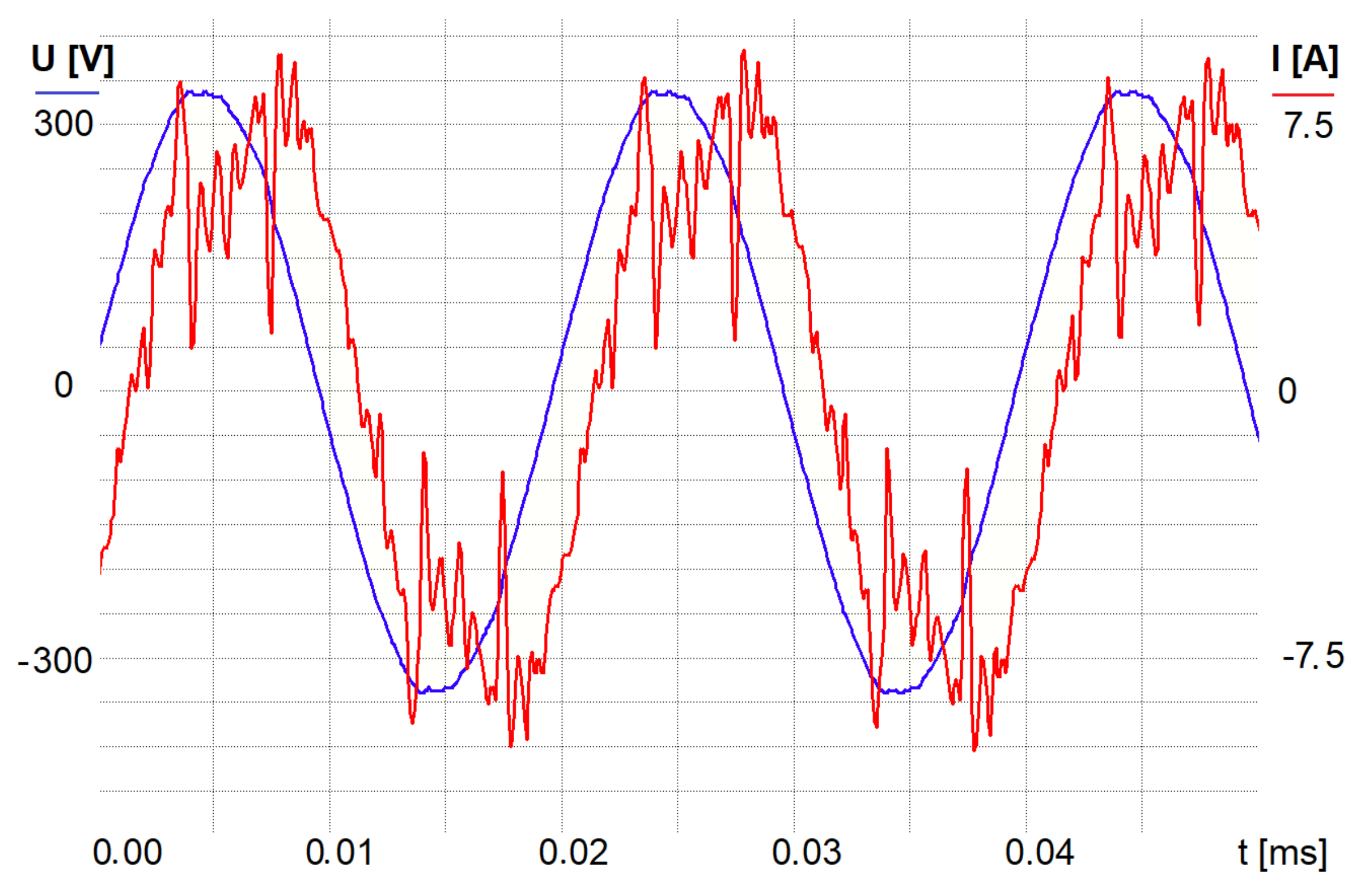
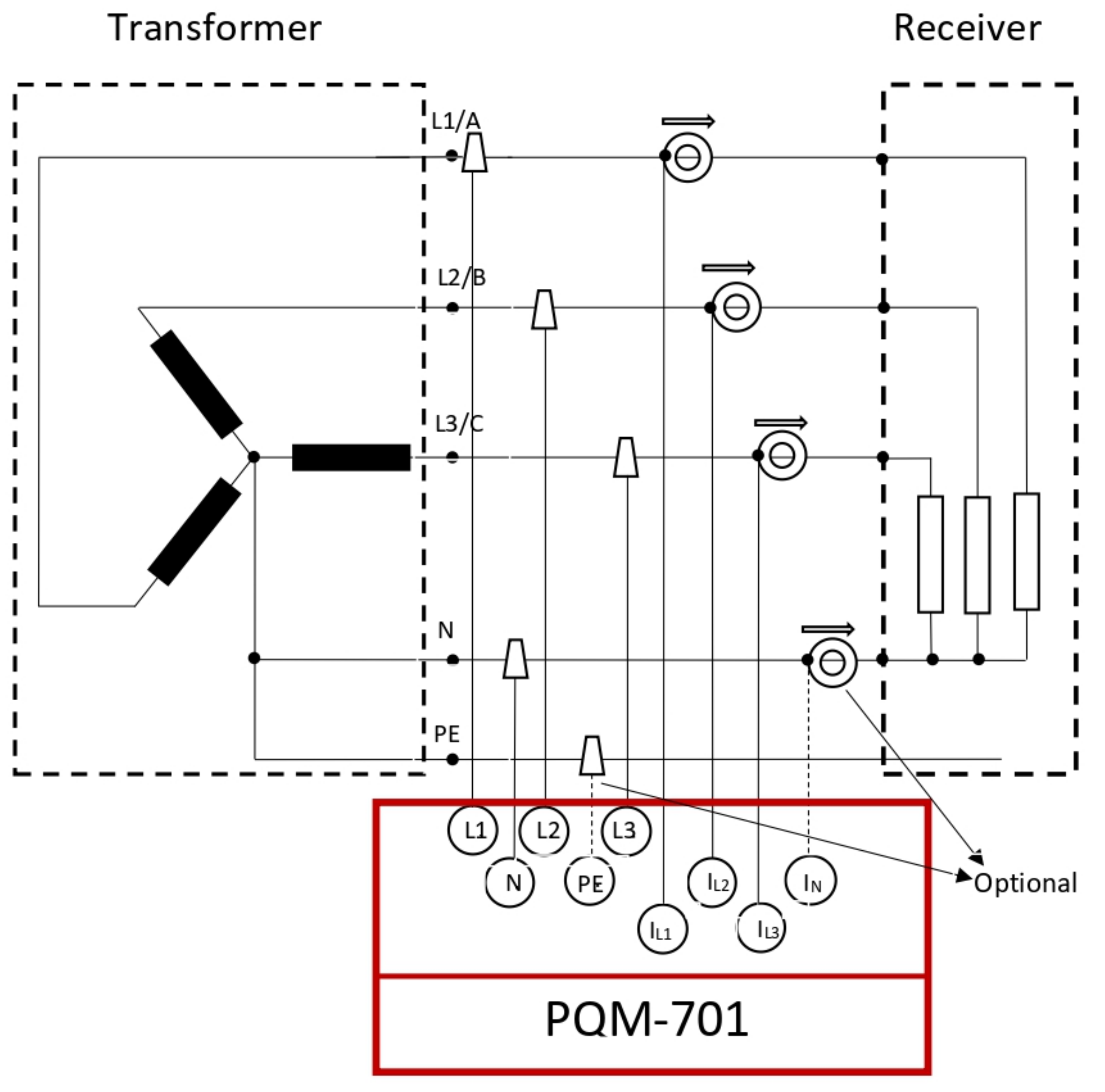

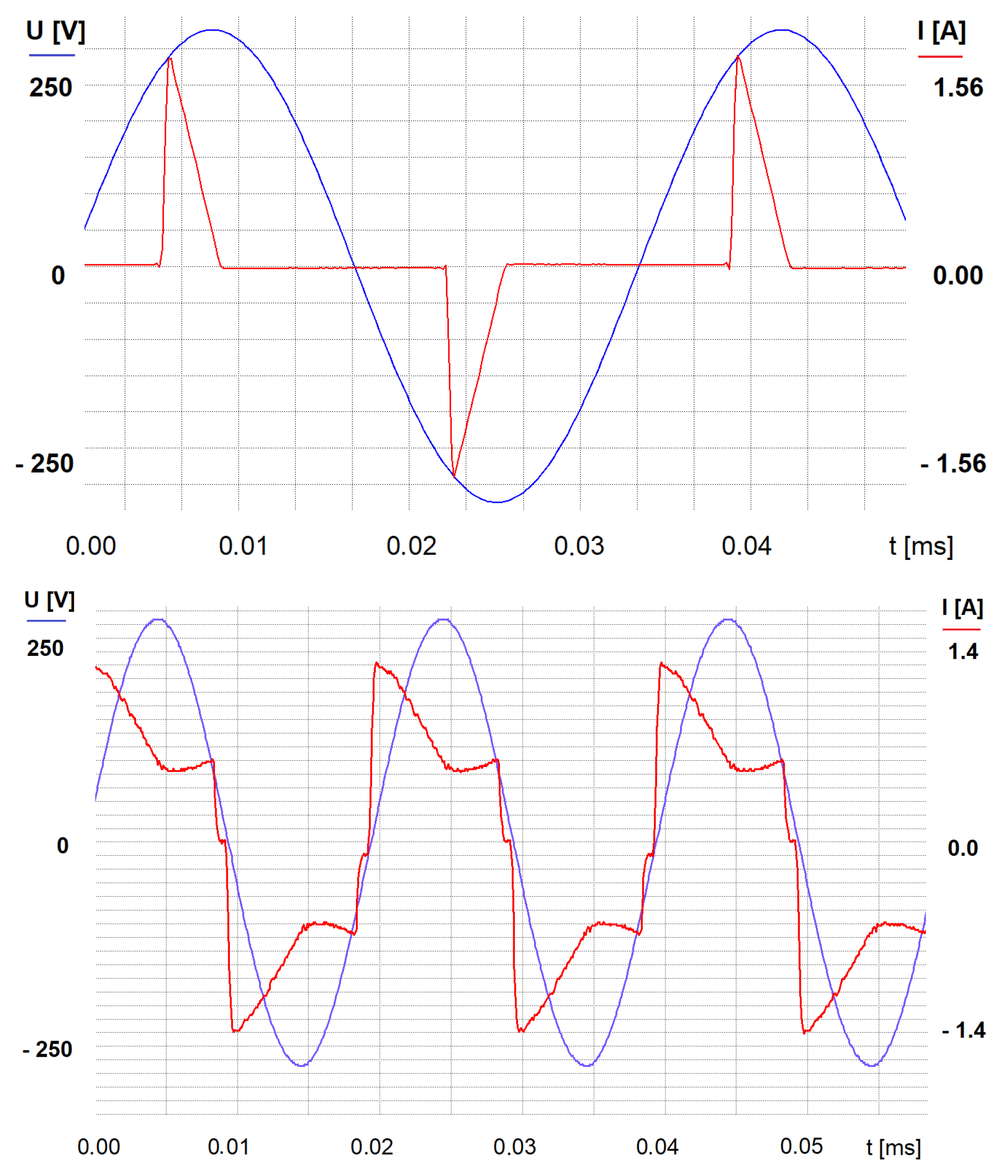


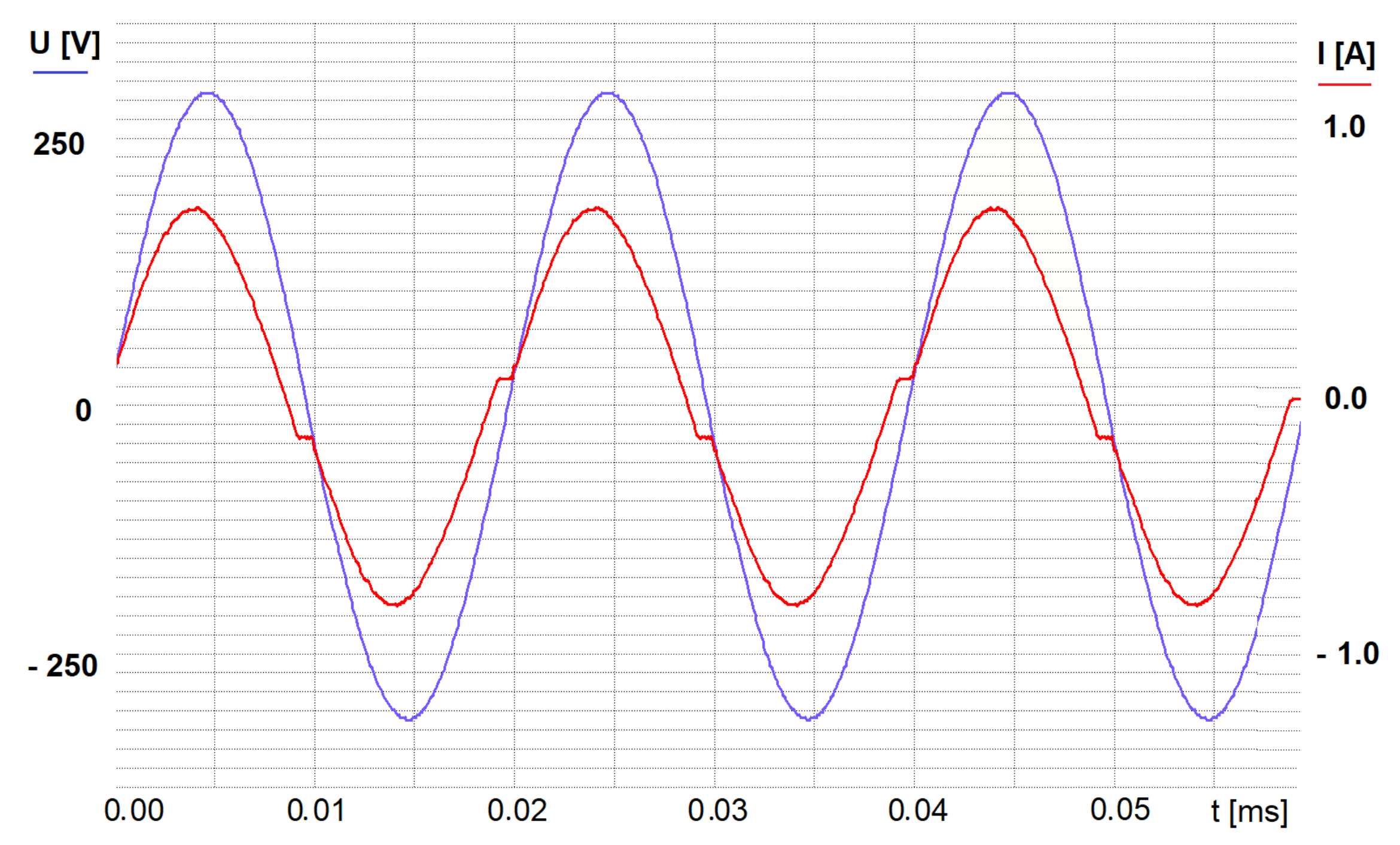
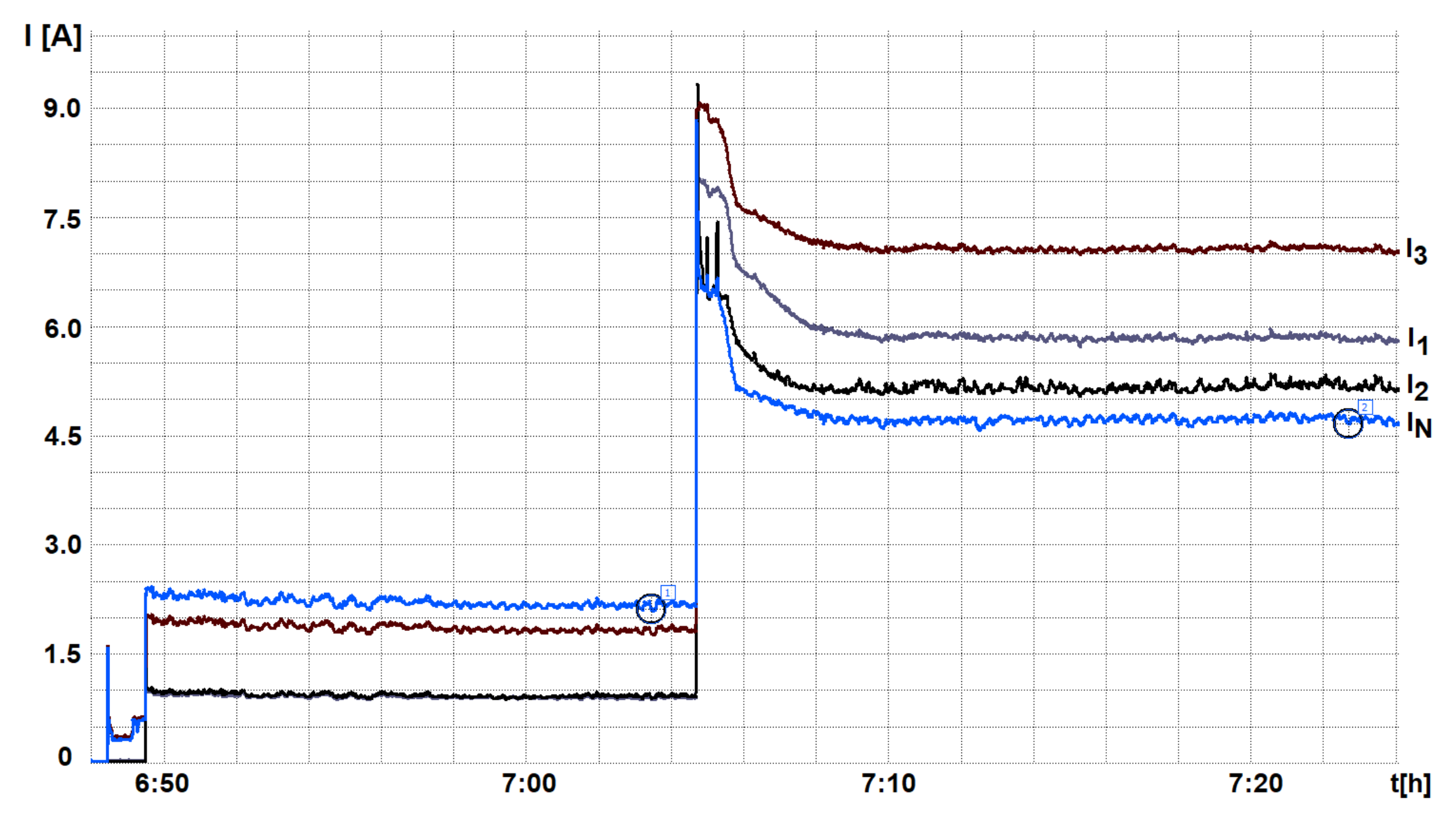
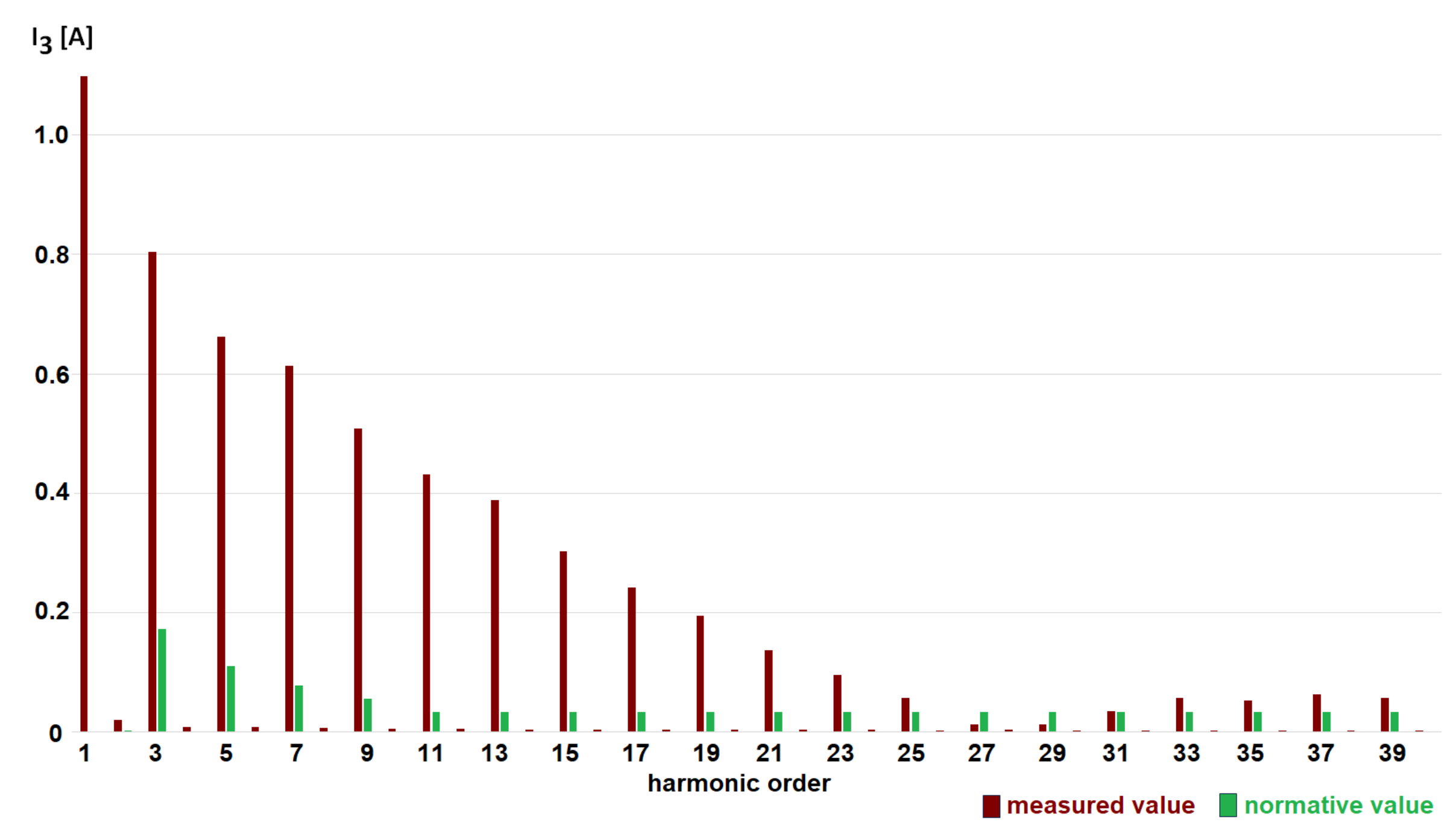
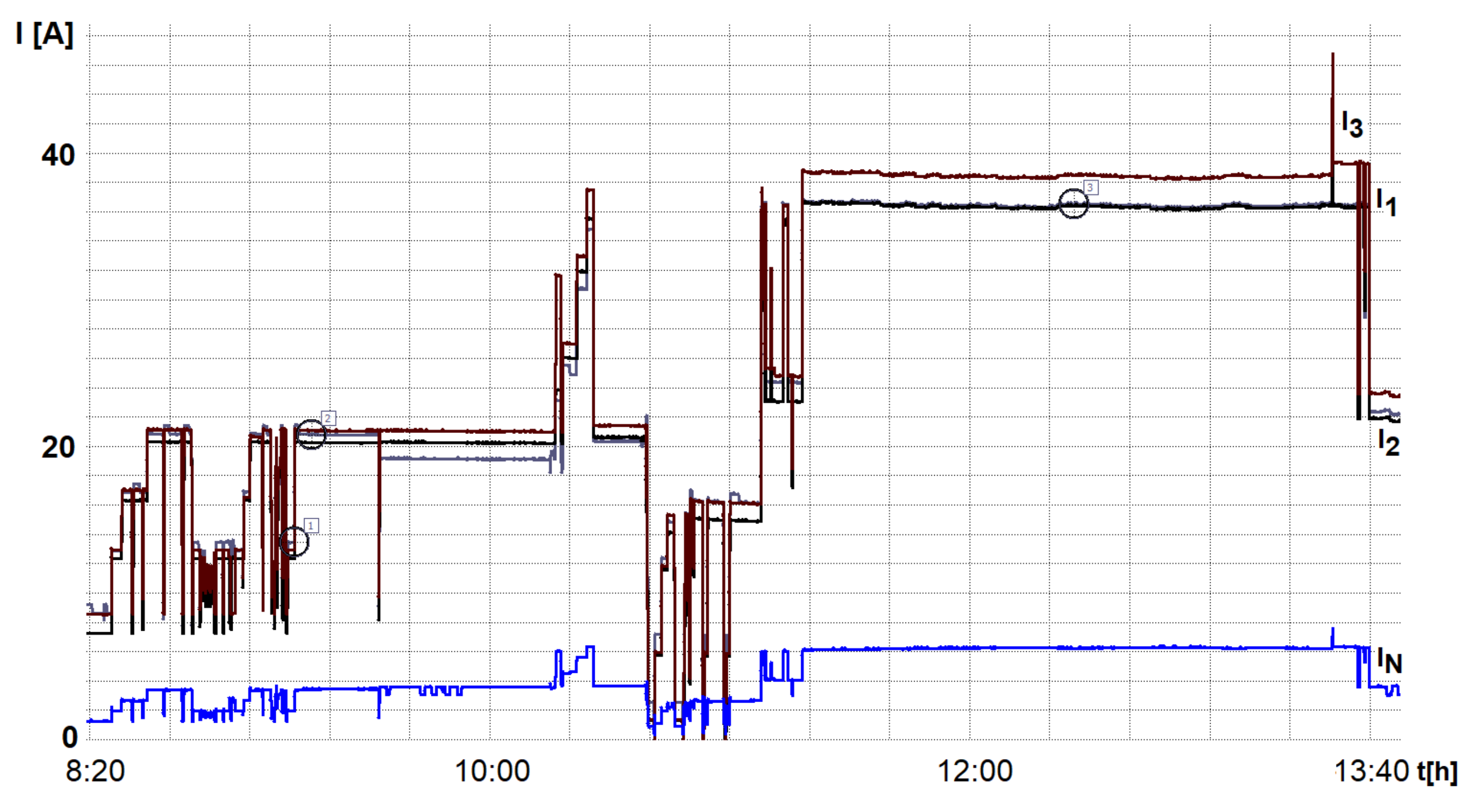
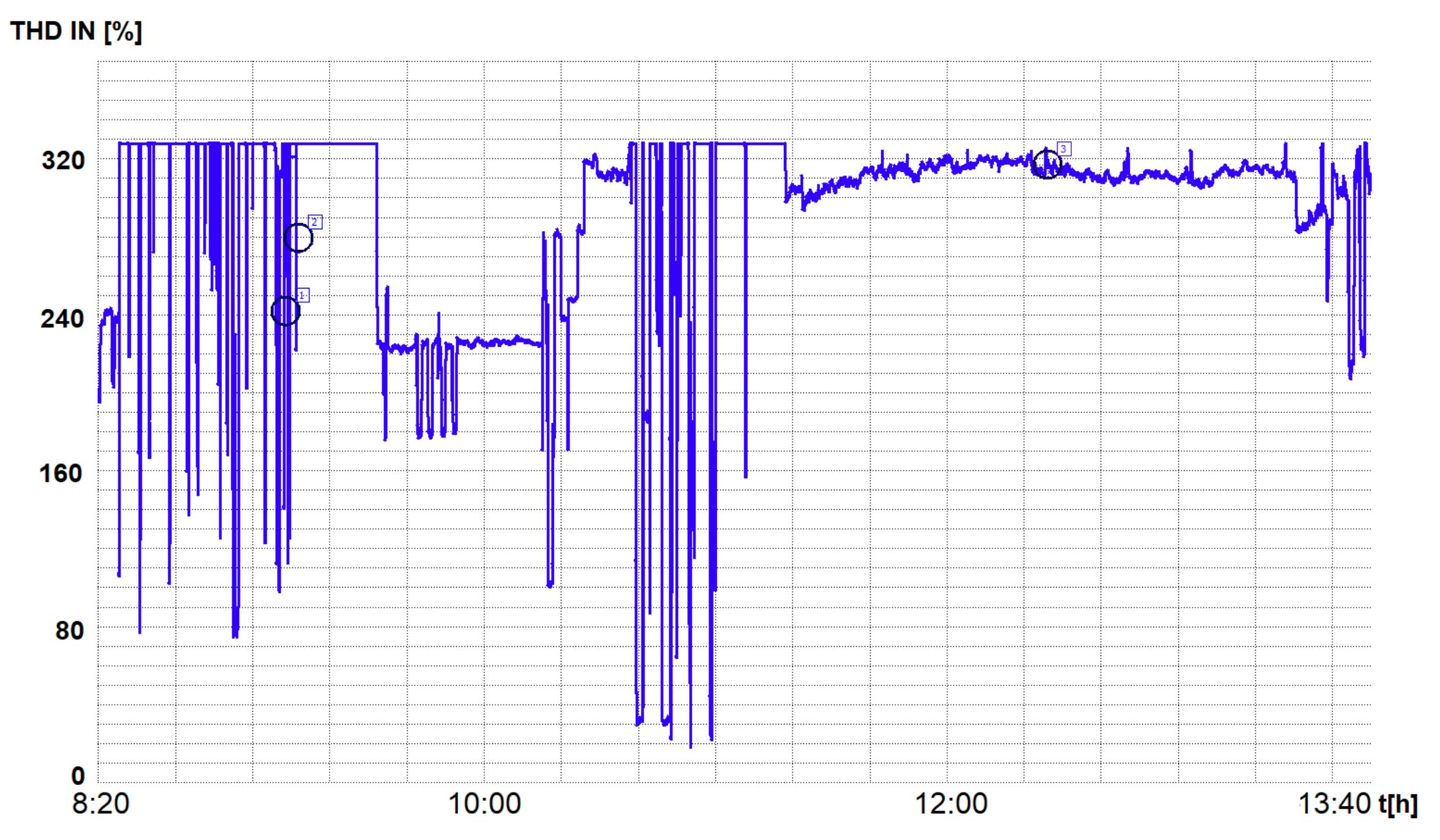
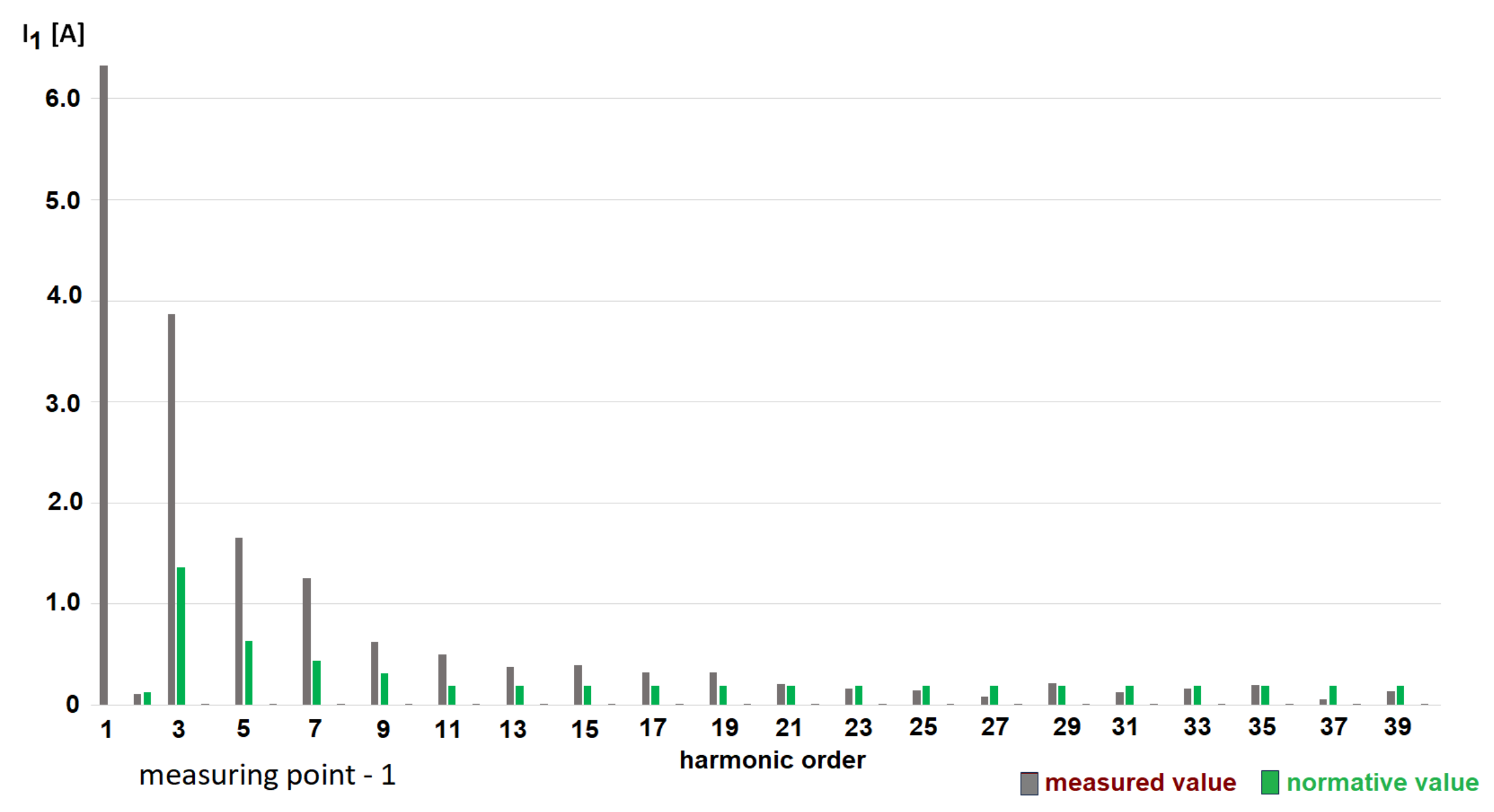

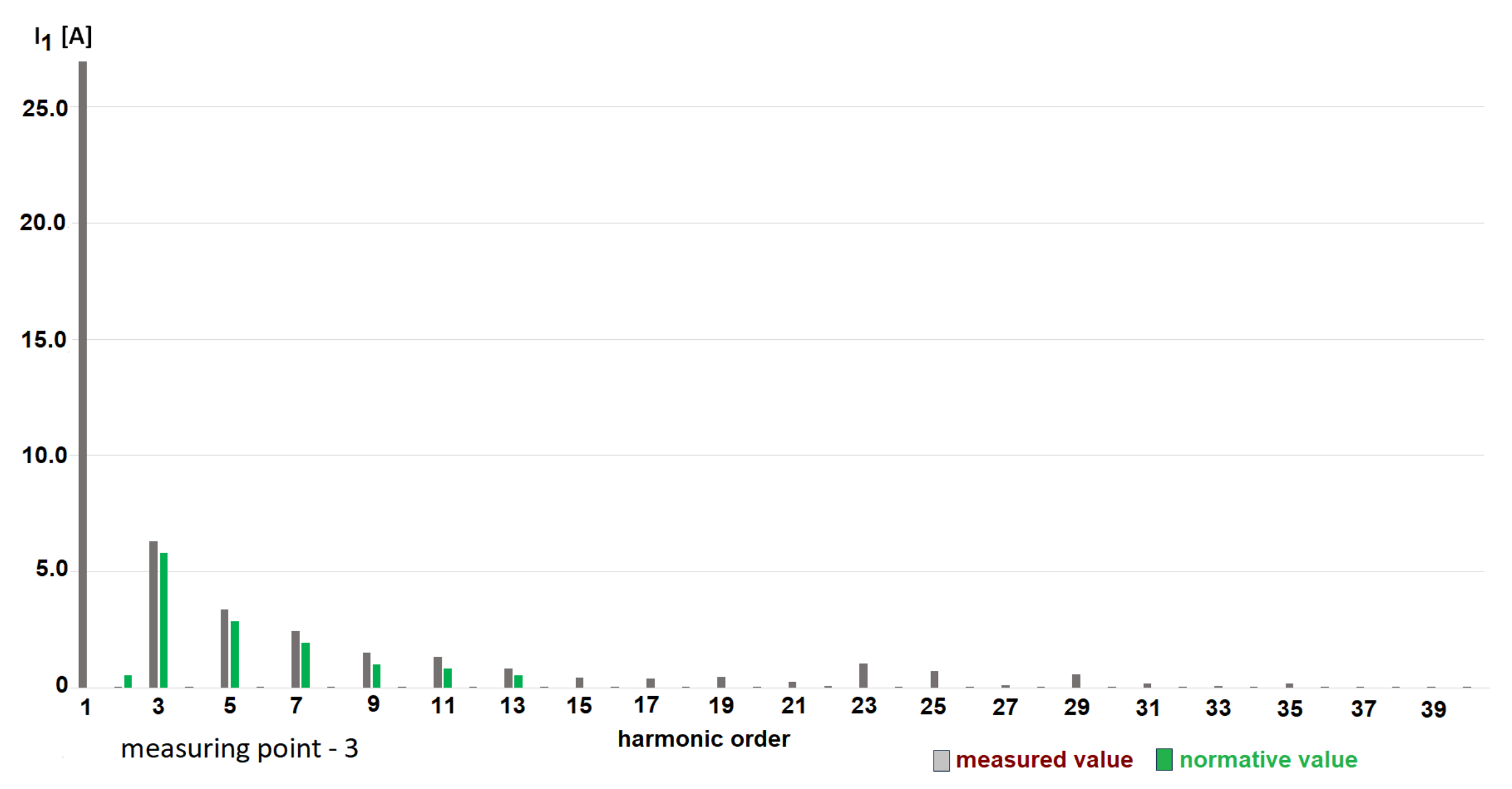
|
Harmonic Order h | Maximum Permissible Harmonic Current Expressed as a Percentage of the Input Current at the Fundamental Frequency | ||
|---|---|---|---|
| (%) | |||
| Receivers with a rated current less than 16 A with a power in the range from 5 W to 25 W [11,13] | Receivers with a rated current less than 16 A with a power of more than 25 W [11,13] | Receivers with a rated current greater than 16 A [12,13] | |
| 2 | 5 | 2 | - |
| 3 | 35 | 27 | 21.6 |
| 5 | 25 | 10 | 10.7 |
| 7 | 30 | 7 | 7.2 |
| 9 | 20 | 5 | 3.8 |
| 11 | 20 | 3 | 3.1 |
| 13 | 20 | 3 | 2.0 |
| 15 ≥ h ≥ 39 (odd harmonics only) | - | 3 | - |
| No. | Type of Light Source | Measured Electrical Parameters | |||||||
|---|---|---|---|---|---|---|---|---|---|
| U | P | I | Q | S | DF (cos) | PF () | THD | ||
| (V) | (W) | (A) | (var) | (VA) | (-) | (-) | (%) | ||
| 1 | LED | 230.50 | 3.023 | 0.03 | −1.149 | 6.501 | 0.936 | 0.470 | 171.00 |
| 2 | LED | 230.30 | 5.696 | 0.05 | −3.478 | 12.65 | 0.857 | 0.450 | 158.20 |
| 3 | Discharge | 230.20 | 86.54 | 0.39 | −13.35 | 90.19 | 0.940 | 0.950 | 24.99 |
| 4 | Discharge | 230.20 | 150.54 | 0.71 | 29.11 | 167.19 | 0.900 | 0.834 | 34.15 |
| 5 | LED | 230.40 | 115.3 | 0.52 | −29.08 | 124.2 | 0.970 | 0.964 | 9.00 |
| Circuit Number | Total Circuit Power | LED Luminaires | Discharge Luminaires |
|---|---|---|---|
| (W) | P (W) | P (W) | |
| 1 | 1063 | 82 | 981 |
| 2 | 1111 | 88 | 1023 |
| 3 | 1322 | 261 | 1061 |
| Harmonic Order | I * | I ** | I *** | I **** |
|---|---|---|---|---|
| (A) | (A) | (A) | (A) | |
| Number | Effective value | |||
| 1 | 0.359 | 0.380 | 1.099 | 0.683 |
| 3 | 0.353 | 0.361 | 0.804 | 1.498 |
| 5 | 0.336 | 0.343 | 0.663 | 0.350 |
| 7 | 0.320 | 0.325 | 0.613 | 0.332 |
| 9 | 0.301 | 0.302 | 0.508 | 1.074 |
| 11 | 0.271 | 0.273 | 0.431 | 0.231 |
| 13 | 0.244 | 0.251 | 0.388 | 0.224 |
| 15 | 0.214 | 0.225 | 0.303 | 0.695 |
| 17 | 0.180 | 0.192 | 0.242 | 0.161 |
| 19 | 0.150 | 0.163 | 0.194 | 0.117 |
| 21 | 0.120 | 0.132 | 0.136 | 0.355 |
| 23 | 0.091 | 0.098 | 0.095 | 0.088 |
| 25 | 0.068 | 0.069 | 0.056 | 0.063 |
| 27 | 0.049 | 0.047 | 0.012 | 0.095 |
| 29 | 0.038 | 0.033 | 0.013 | 0.036 |
| 31 | 0.036 | 0.032 | 0.035 | 0.023 |
| 33 | 0.039 | 0.037 | 0.057 | 0.130 |
| 35 | 0.042 | 0.039 | 0.053 | 0.014 |
| 37 | 0.045 | 0.041 | 0.063 | 0.029 |
| 39 | 0.045 | 0.041 | 0.056 | 0.136 |
| Reducing Factor k | ||
|---|---|---|
| Selection of the Cross-Section of the Conductors on the Basis of the Phase Current Value | Selection of the Cross-Section of the Conductors on the Basis of the Value of the Neutral Current | |
| - | - | |
| 0–15 | 1.00 | - |
| 15–33 | 0.86 | - |
| 33–45 | - | 0.86 |
| >45 | - | 1.00 |
| Operating Current Value | Wire Cross-Section | ||||
|---|---|---|---|---|---|
| (*) | (**) | ||||
| 53.59 A | 55.17 A | ||||
| (*) | (**) |
Disclaimer/Publisher’s Note: The statements, opinions and data contained in all publications are solely those of the individual author(s) and contributor(s) and not of MDPI and/or the editor(s). MDPI and/or the editor(s) disclaim responsibility for any injury to people or property resulting from any ideas, methods, instructions or products referred to in the content. |
© 2023 by the authors. Licensee MDPI, Basel, Switzerland. This article is an open access article distributed under the terms and conditions of the Creative Commons Attribution (CC BY) license (https://creativecommons.org/licenses/by/4.0/).
Share and Cite
Popławski, T.; Kurkowski, M. Nonlinear Loads in Lighting Installations—Problems and Threats. Energies 2023, 16, 6024. https://doi.org/10.3390/en16166024
Popławski T, Kurkowski M. Nonlinear Loads in Lighting Installations—Problems and Threats. Energies. 2023; 16(16):6024. https://doi.org/10.3390/en16166024
Chicago/Turabian StylePopławski, Tomasz, and Marek Kurkowski. 2023. "Nonlinear Loads in Lighting Installations—Problems and Threats" Energies 16, no. 16: 6024. https://doi.org/10.3390/en16166024
APA StylePopławski, T., & Kurkowski, M. (2023). Nonlinear Loads in Lighting Installations—Problems and Threats. Energies, 16(16), 6024. https://doi.org/10.3390/en16166024








